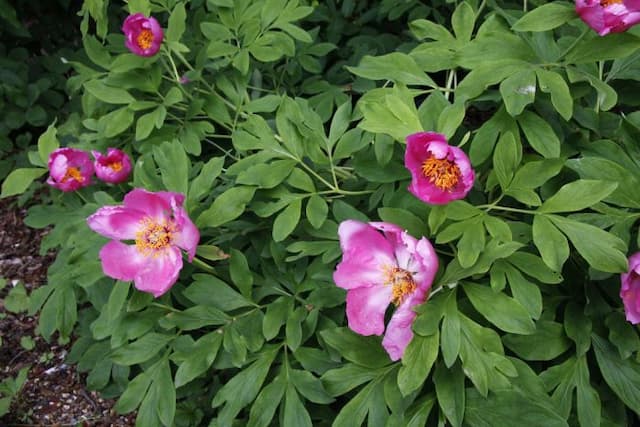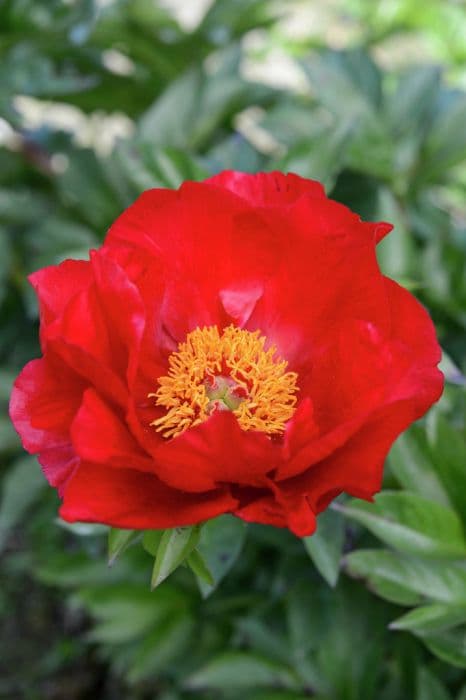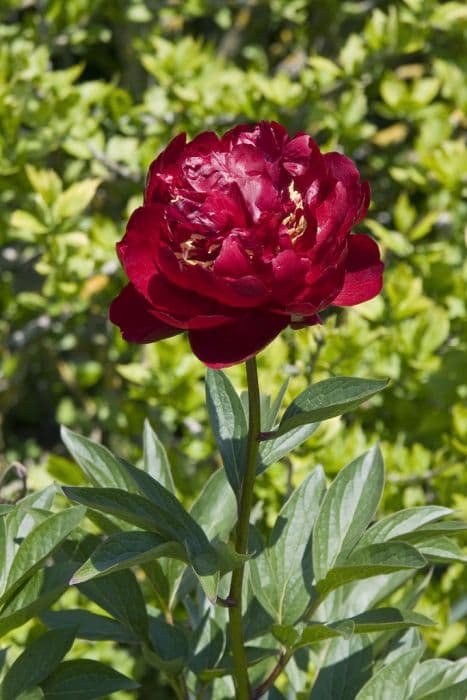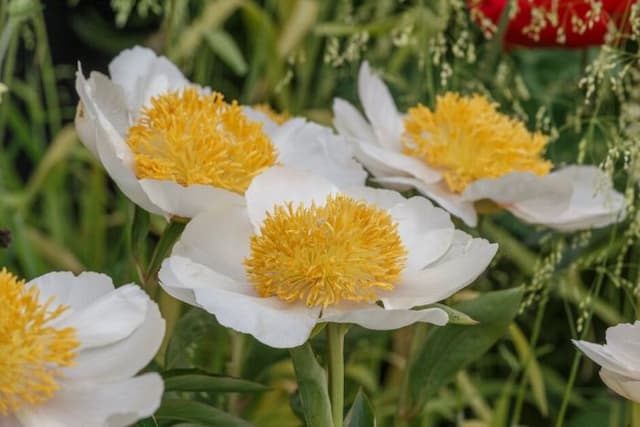Chinese peony Paeonia lactiflora 'Nymphe'

ABOUT
The Paeonia lactiflora 'Nymphe,' commonly known as the Chinese peony 'Nymphe,' carries a romantic and delicate appearance that has charmed garden enthusiasts for years. This particular variety is adorned with exquisite double blossoms that feature a soft, pale pink hue. Each flower is made up of numerous ruffled petals that create a lush, rounded form characteristic of double peonies. At the center of the blossoms, hints of a slightly deeper pink can occasionally be seen, adding depth and contrast to the flower's overall presentation. The blossoms of 'Nymphe' emit a sweet and enticing fragrance, which makes them highly attractive to both humans and pollinators alike. This fragrance intensifies as the voluptuous flowers fully open under the warmth of spring. The foliage of the 'Nymphe' is an attractive deep green, providing a striking backdrop for the flowers. The leaves are glossy with a leathery texture and have a typical lance shape with a pointed tip. The Chinese peony 'Nymphe' blooms in late spring to early summer, with the lush flowers creating a spectacular show that can transform any garden space. This plant is often prized for its cut flowers due to their large size, enchanting appearance, and delightful fragrance, making it a favored choice for floral arrangements and bouquets. Overall, the 'Nymphe' encapsulates the elegance and beauty that peonies are celebrated for, delivering a touch of classic charm to the landscape.
About this plant
 Names
NamesFamily
Paeoniaceae
Synonyms
Chinese Peony, White Peony
Common names
Paeonia lactiflora 'Nymphe'.
 Toxicity
ToxicityTo humans
Peonies like Paeonia lactiflora 'Nymphe', commonly known as the common garden peony, are not highly toxic to humans. While they are not intended for consumption, ingestion of parts of the plant may lead to mild stomach upset in some individuals. It is generally advised to avoid eating peonies, but serious poisoning from casual handling or accidental ingestion is unlikely.
To pets
Peonies, including the common garden peony, are considered mildly toxic to pets, such as cats and dogs. If a pet ingests part of the plant, they may experience gastrointestinal upset, characterized by symptoms such as vomiting or diarrhea. It's recommended to keep peonies out of reach of pets to avoid these potential negative effects.
 Characteristics
CharacteristicsLife cycle
Perennials
Foliage type
Deciduous
Color of leaves
Green
Flower color
Pink
Height
2-3 feet (0.6-0.9 meters)
Spread
2-3 feet (0.6-0.9 meters)
Plant type
Herb
Hardiness zones
3-8
Native area
Asia
Benefits
 General Benefits
General Benefits- Aesthetic Appeal: The Paeonia lactiflora 'Nymphe', commonly known as the Chinese peony, produces attractive large blooms that enhance garden aesthetics. The delicate, pale pink flowers are a highlight in spring and early summer.
- Garden Design Versatility: Chinese peonies offer versatility in landscape design, suitable for mixed borders, flowerbeds, and as specimen plants.
- Pollinator Attraction: The fragrant blooms attract bees and other pollinators, supporting local ecosystems and aiding in pollination of surrounding plants.
- Longevity: Chinese peonies are known for their long lifespan. With proper care, they can thrive for decades and become a perennial garden staple.
- Seasonal Interest: Beyond their blooming period, the foliage of Chinese peonies provides greenery through the season, turning to attractive hues in the fall.
- Ease of Care: Once established, Chinese peonies require relatively low maintenance, making them suitable for gardeners of varying experience levels.
- Cut Flower Use: The blooms are excellent for cut flower arrangements, with a vase life of around 7 to 10 days, extending the enjoyment of their beauty indoors.
- Cultural Significance: In some cultures, peonies are associated with romance, prosperity, and good fortune, adding symbolic value to the garden.
 Medical Properties
Medical Properties- Anti-inflammatory: Paeonia lactiflora has compounds that may reduce inflammation.
- Antioxidant: It contains antioxidants that can help in protecting the body from oxidative stress.
- Immunomodulatory effects: Some studies suggest that it can modulate the immune system.
- Anxiolytic: May have a calming effect on the nervous system.
- Analgesic: Has been traditionally used to alleviate pain.
- Antispasmodic: Might help in relieving muscle spasms.
 Air-purifying Qualities
Air-purifying QualitiesThis plant is not specifically known for air purifying qualities.
 Other Uses
Other Uses- Culinary Garnish: The petals of the common peony can be candied or used fresh to add a colorful, slightly spicy touch to desserts and salads.
- Fabric Dye: The blossoms of the peony provide natural dyes for fabrics, yielding colors from pink to purple depending on the mordant used.
- Artistic Inspiration: Artists often use the intricate blooms of the peony as subjects in paintings, drawings, and photography.
- Feng Shui: In some cultures, peonies are associated with good fortune and wealth in Feng Shui, making them popular plants in home landscaping for positive energy.
- Symbolic Gift: Common peonies are a traditional floral gift in certain cultures, symbolizing honor, prosperity, and a happy marriage, often used in wedding bouquets and centerpieces.
- Eco-printing: Leaves and flowers of peonies can be used for eco-printing, a natural process where plant materials leave their shapes and colors on paper or fabric.
- Handcrafts: Peony blooms and petals can be incorporated into handcrafted soaps, candles, and potpourri for their shape and fragrance.
- Flower Arranging: The full, lush blooms of common peonies make them a favorite among florists and gardeners for creating eye-catching floral arrangements.
- Botanical Studies: As a species with diverse cultivars, common peonies are studied for their genetic variations and hybridization potential.
- Event Decor: Due to their large, showy blooms, common peonies are used to decorate venues for events such as parties or exhibitions for their aesthetic appeal.
Interesting Facts
 Feng Shui
Feng ShuiThe Peony is used in Feng Shui as a symbol of romance, prosperity, and good fortune. It is often recommended to place Peonies in the southwest corner of a garden or room to enhance love and marital happiness.
 Zodiac Sign Compitability
Zodiac Sign CompitabilityThe Peony is not used in astrology practice.
 Plant Symbolism
Plant Symbolism- Prosperity: The Paeonia lactiflora 'Nymphe', commonly known as Peony, is often associated with abundance and good fortune, making it a popular choice for celebrations that wish to convey wishes of wealth and prosperity.
- Honor and Nobility: Peonies symbolize honor and nobility in many cultures, reflecting the high esteem with which this flower is often regarded due to its lush, full blooms and rich history.
- Romance: With its full, rounded petals, the Peony is frequently used to represent romantic love and is a popular choice in wedding bouquets and decorations.
- Beauty in all forms: The Peony signifies beauty not just in the sense of physical appearance but also the beauty of one’s inner soul, making it a thoughtful gift to express admiration for someone’s grace and elegance.
- Happy Marriage: Because of its use in weddings and its lush, luxurious petals, the Peony is also a symbol of a happy marriage, often used to wish newlyweds a blissful life together.
- Compassion: Some cultures find the Peony to be a representation of compassion and nurturing, possibly due to the way the blooms provide shelter to smaller creatures and the nurturing nature required to grow these sometimes finicky plants.
 Water
WaterPeonies require consistent moisture, especially during their flowering season. For your Peony 'Nymphe', water it deeply once a week, providing about 1 gallon of water per plant. In times of drought or extreme heat, increase the frequency to twice a week ensuring the soil remains moist but not waterlogged. During the fall and winter, reduce watering as the plant goes dormant. The best method is to water at the base of the plant to avoid wetting the foliage, as this can lead to fungal diseases.
 Light
LightPeony 'Nymphe' thrives best in full sun to partial shade. Choose a spot where the plant can receive at least 6 to 8 hours of sunlight daily. Morning light is especially beneficial as it warms the plant and helps dry dew on the leaves, minimizing the risk of disease. If you live in a hotter climate, provide some afternoon shade to prevent overheating.
 Temperature
TemperaturePeonies like 'Nymphe' are cold-hardy and prefer a temperate climate. The ideal temperature range for growing peonies is between 65°F and 75°F. They can tolerate winter temperatures as low as -20°F and summer temperatures as high as 90°F. It’s important to ensure they experience a period of winter chill to properly set buds for the next flowering season.
 Pruning
PruningPrune Peony 'Nymphe' to remove spent blooms after flowering and to deadhead. This encourages more blooms and maintains a tidy appearance. In late fall, cut back the foliage to within a few inches of the ground after the first frost to help control disease and prepare the plant for winter. Prune any damaged or diseased stems as needed throughout the growing season to maintain plant health.
 Cleaning
CleaningAs needed
 Soil
SoilThe ideal soil mix for the Peony 'Nymphe' should be fertile, well-drained with a pH of 6.5 to 7.0. A combination of loamy soil enriched with compost and peat moss can provide the necessary nutrients and structure. Good drainage is crucial to avoid root rot, so incorporating perlite or sand can help maintain the right soil consistency.
 Repotting
RepottingPeonies, including the 'Nymphe' variety, generally do not need to be repotted frequently as they prefer to be left undisturbed. They can thrive in the same spot for many years, but if you must move or divide them, it's best to do so in the fall every 10 to 15 years.
 Humidity & Misting
Humidity & MistingThe Peony 'Nymphe' does well in average outdoor humidity levels; they do not require high humidity. As long as the plant is watered appropriately at ground level and the leaves are kept dry, ambient humidity rarely poses a problem.
 Suitable locations
Suitable locationsIndoor
Not ideal for indoors; requires deep planting, cool winter period.
Outdoor
Full sun, well-drained soil, plant in fall or spring, deep watering.
Hardiness zone
3-8 USDA
 Life cycle
Life cyclePaeonia lactiflora 'Nymphe', commonly known as Chinese peony 'Nymphe', begins its life cycle as a dormant tuberous root in winter. With the arrival of spring, it breaks dormancy and sprouts, producing stems and deeply lobed leaves as it enters into the vegetative growth stage. As the plant matures, it develops flower buds that bloom in late spring to early summer, showcasing large, fragrant pink flowers that attract pollinators. After flowering, the plant sets seed in the form of a capsule, which ripens by late summer and releases seeds once it splits open. These seeds can be dispersed to generate new plants, completing the cycle of reproduction. In autumn, the aerial parts of the peony die back as it re-enters dormancy, conserving energy in its root system for the next growing season.
 Propogation
PropogationPropogation time
Spring to Summer
The most popular method of propagation for the Chinese peony 'Nymphe' is by division of the root system. This is typically done in the fall after the plant has gone dormant. To propagate, carefully dig up the entire plant, making sure to lift the root ball out of the ground with minimal damage. The root ball is then gently cleaned of excess soil and the roots are divided into sections using a sharp knife, ensuring that each section has at least three to five buds, often referred to as "eyes." These sections can be immediately replanted at the same depth they were originally growing, making sure the eyes are no more than 2 inches (approximately 5 cm) below the soil surface. This method allows for the propagation of genetically identical copies of the 'Nymphe' peony, ensuring the preservation of its particular characteristics.









